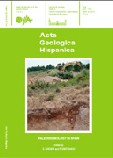Evidence for coseismic events of recurrent prehistoric deformation along the Alhama de Murcia fault, southeastern Spain
Abstract
The Alhama de Murcia fault is a 85 km long oblique-slip fault, and is related to historical and instrumental seismic activity. A paleoseismic analysis of the Lorca-Totana sector of the fault containing MSK I=VIII historical earthquakes was made in order to identify and quantify its seismic potential. We present 1) the results of the neotectonic, structural and geomorphological analyses and, 2) the results of trenching. In the study area, the Alhama de Murcia fault forms a depressed corridor between two strands, the northwestern fault with morphological and structural features of a reverse component of slip, bounding the La Tercia range to the South, and the southeastern fault strand with evidence of sinistral oblique strike-slip movement. The offset along this latter fault trapped the sediments in transit from the La Tercia range towards the Guadalentín depression. The most recent of these sediments are arranged in three generations of alluvial fans and terraces. The first two trenches were dug in the most recent sediments across the southeastern fault strand. The results indicate a coseismic reverse fault deformation that involved the sedimentary sequence up to the intermediate alluvial fan and the Holocene terrace deposits. The sedimentary evolution observed in the trenches suggests an event of temporary damming of the Colmenar creek drainage to the South due to uplifting of the hanging wall during coseismic activation of the fault. Trench, structural and sedimentological features provide evidence of at least three coseismic events, which occurred after 125,000yr. The minimum vertical slip rate along the fault is 0.06mm/yr and the average recurrence period should not exceed 40,000yr in accordance with the results obtained by fan topographic profiling. Further absolute dating is ongoing to constrain these estimates.


